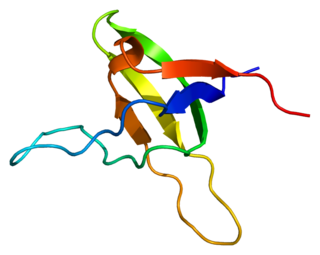
In linguistics, morphology is the study of words, how they are formed, and their relationship to other words in the same language. It analyzes the structure of words and parts of words such as stems, root words, prefixes, and suffixes. Morphology also looks at parts of speech, intonation and stress, and the ways context can change a word's pronunciation and meaning. Morphology differs from morphological typology, which is the classification of languages based on their use of words, and lexicology, which is the study of words and how they make up a language's vocabulary.

In genetics, the phenotype is the set of observable characteristics or traits of an organism. The term covers the organism's morphology, its developmental processes, its biochemical and physiological properties, its behavior, and the products of behavior. An organism's phenotype results from two basic factors: the expression of an organism's genetic code and the influence of environmental factors. Both factors may interact, further affecting the phenotype. When two or more clearly different phenotypes exist in the same population of a species, the species is called polymorphic. A well-documented example of polymorphism is Labrador Retriever coloring; while the coat color depends on many genes, it is clearly seen in the environment as yellow, black, and brown. Richard Dawkins in 1978 and then again in his 1982 book The Extended Phenotype suggested that one can regard bird nests and other built structures such as caddisfly larva cases and beaver dams as "extended phenotypes".

A phenotypic trait, simply trait, or character state is a distinct variant of a phenotypic characteristic of an organism; it may be either inherited or determined environmentally, but typically occurs as a combination of the two. For example, having eye color is a character of an organism, while blue, brown and hazel versions of eye color are traits. The term trait is generally used in genetics, often to describe phenotypic expression of different combinations of alleles in different individual organisms within a single population, such as the famous purple vs. white flower coloration in Gregor Mendel's pea plants. By contrast, in systematics, the term is character state is employed to describe features that represent fixed diagnostic differences among taxa, such as the absence of tails in great apes, relative to other primate groups.

The Medical Research Council (MRC) is responsible for co-coordinating and funding medical research in the United Kingdom. It is part of United Kingdom Research and Innovation (UKRI), which came into operation 1 April 2018, and brings together the UK's seven research councils, Innovate UK and Research England. UK Research and Innovation is answerable to, although politically independent from, the Department for Business, Energy and Industrial Strategy.

Morphology is a branch of biology dealing with the study of the form and structure of organisms and their specific structural features.

Neodiapsida is a clade, or major branch, of the reptilian family tree, typically defined as including all diapsids apart from some early primitive types known as the araeoscelidians. Modern reptiles and birds belong to the neodiapsid subclade Sauria.

In biology, a species complex is a group of closely related organisms that are so similar in appearance and other features that the boundaries between them are often unclear. The taxa in the complex may be able to hybridize readily with each other, further blurring any distinctions. Terms that are sometimes used synonymously but have more precise meanings are cryptic species for two or more species hidden under one species name, sibling species for two species that are each other's closest relative, and species flock for a group of closely related species that live in the same habitat. As informal taxonomic ranks, species group, species aggregate, macrospecies, and superspecies are also in use.
A phene is an individual genetically determined characteristic or trait which can be possessed by an organism, such as eye colour, height, behavior, tooth shape or any other observable characteristic.

Shovel-shaped incisors are incisors whose lingual surfaces are scooped as a consequence of lingual marginal ridges, crown curvature, or basal tubercles, either alone or in combination.

Obscurin is a protein that in humans is encoded by the OBSCN gene. Obscurin belongs to the family of giant sarcomeric signaling proteins that includes titin and nebulin. Obscurin is expressed in cardiac and skeletal muscle, and plays a role in the organization of myofibrils during sarcomere assembly. A mutation in the OBSCN gene has been associated with hypertrophic cardiomyopathy and altered obscurin protein properties have been associated with other muscle diseases.

Homeobox protein Hox-A3 is a protein that in humans is encoded by the HOXA3 gene.
A species (pl. species) in biology is often defined as the largest group of organisms in which any two individuals of the appropriate sexes or mating types can produce fertile offspring, typically by sexual reproduction. It is the basic unit of classification and a taxonomic rank of an organism, as well as a unit of biodiversity. Other ways of defining species include their karyotype, DNA sequence, morphology, behaviour, or ecological niche. In addition, paleontologists use the concept of the chronospecies since fossil reproduction cannot be examined.
Dollosuchoides, colloquially known as the Crocodile of Maransart, is an extinct monospecific genus of gavialoid crocodilian, traditionally regarded as a member of the subfamily Tomistominae. Fossils have been found in the Brussel Formation of Maransart, Belgium and date back to the middle Eocene.

SAR or Harosa is a highly diverse clade of eukaryotes, often considered a supergroup, that includes stramenopiles (heterokonts), alveolates, and rhizarians. It is a node-based taxon, including all descendants of the three groups' last common ancestor, and comprises most of the now-rejected Chromalveolata. Their sister group has been found to be telonemids, with which they make up the TSAR clade.
Maroccosuchus zennaroi is an extinct gavialoid crocodylian from the Early Eocene of Morocco, traditionally regarded as a member of the subfamily Tomistominae.
Paratomistoma is an extinct monospecific genus of gavialoid crocodylian. It is based on the holotype specimen CGM 42188, a partial posterior skull and lower jaw discovered at Wadi Hitan, Egypt, in Middle Eocene-age rocks of the Gehannam Formation. The skull is unfused but considered morphologically mature. Paratomistoma was named in 2000 by Christopher Brochu and Philip Gingerich; the type species is P. courti in honor of Nicholas Court, who found CGM 42188. They performed a phylogenetic analysis and found Paratomistoma to be a derived member of Tomistominae, related to the false gharial. It may have been a marine or coastal crocodilian.
The Uber-anatomy ontology (Uberon) is a comparative anatomy ontology representing a variety of structures found in animals, such as lungs, muscles, bones, feathers and fins. These structures are connected to other structures via relationships such as part-of and develops-from. One of the uses of this ontology is to integrate data from different biological databases, and other species-specific ontologies such as the Foundational Model of Anatomy.
Jeremy K. Nicholson is a professor and pro vice chancellor of Health Sciences at Murdoch University in Perth, Western Australia, where he leads the Australian National Phenome Centre. He is also an emeritus professor of Biological Chemistry at Imperial College London and was the director and principal investigator of the MRC-NIHR National Phenome Centre until 2018.
Tomistoma cairense is an extinct species of gavialoid crocodilian from the Lutetian stage of the Eocene era. It lived in North East Africa, especially Egypt. Remains of T. cairense have been found in the Mokattam Formation, in Mokattam, Egypt. Tomistoma cairense did not have a Maxilla process within their lacrimal gland, whereas all extant (living) crocodilians do.
In genetics and genetic epidemiology, a phenome-wide association study, abbreviated PheWAS, is a study design in which the association between single-nucleotide polymorphisms or other types of DNA variants is tested across a large number of different phenotypes. The aim of PheWAS studies is to examine the causal linkage between known sequence differences and any type of trait, including molecular, biochemical, cellular, and especially clinical diagnoses and outcomes. It is a complementary approach to the genome-wide association study, or GWAS, methodology. A fundamental difference between GWAS and PheWAS designs is the direction of inference: in a PheWAS it is from exposure to many possible outcomes, that is, from SNPs to differences in phenotypes and disease risk. In a GWAS, the polarity of analysis is from one or a few phenotypes to many possible DNA variants. The approach has proven useful in rediscovering previously reported genotype-phenotype associations, as well as in identifying new ones.









